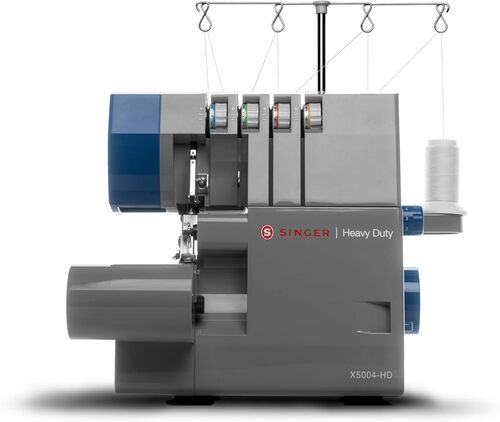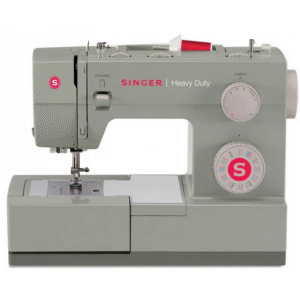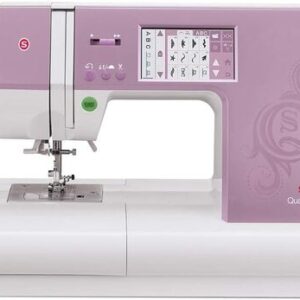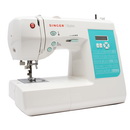
I still remember the thump on my doorstep the morning my serger finally arrived. For weeks I’d been combing through Singer X5004 HD reviews, trying to decide if this “heavy-duty” little workhorse could keep up with my ideas. My regular sewing machine was doing fine, but my knits and raw edges looked, well… homely. I wanted that clean store-bought finish. So I took a deep breath, hit “buy,” and waited for the big brown box like a kid watching for snow.
Unboxing nerves (and a happy surprise)
Under the packing foam sat the Singer X5004 HD, wrapped snug and already threaded with sample cones and a test swatch tucked under the foot. Bless whoever thought of that. I tied on my own cones and pulled the threads through — instant confidence boost before I even had coffee. In the accessory bag were needles, a brush, a tiny screwdriver, and tweezers (usable, though I later swapped them for angled ones). There was no thick paper manual in my box, just a card pointing me to the PDF. Not a deal-breaker, but I do love a real book.
The machine itself looked tough but compact — metal where it matters inside, lighter shell outside. Two bright LEDs lit the throat area better than I expected. The suction-cup feet stuck to my table like a gecko, which helped calm my fear of the “jumping serger” I’d seen in a few videos.
The threading moment of truth
Anyone who reads a single Singer X5004 HD review knows threading is the rite of passage. My machine came pre-threaded, but I forced myself to do a full rethread to learn the paths. The color coding helped, but the lower looper is tucked in a spot that made me wish my fingers were half their size. Angled tweezers and an extra desk lamp were heroes. One tip I picked up after a lot of trial and error: don’t obsess over “3333” tension or any magic numbers. Pull each thread and feel it. If it slides like fishing line, it’s too loose; if it squeaks and sings, it’s too tight. Feeling the tension taught me faster than any chart.
When I finally stepped on the pedal, the X5004 HD settled into a confident whirr — faster than my old machine (it can hit 1300 stitches per minute), but easy to tame with my foot. The sound is a little “metallic,” not silent, but I set the serger on a rubber mat and it mellowed right out.
First stitch, first grin
My test drive was a knit tee I’d hemmed and re-hemmed into sadness. With a 4-thread overlock, the seam looked clean and stretchy in one pass. No tunneling, no wavy lettuce edges. The adjustable differential feed earned its keep right away — turning the dial just a touch kept the knit from rippling, and when I wanted a gentle ruffle for a sleeve, a quick twist in the other direction delivered it on purpose. That was the moment I thought, “Oh…this is what I’ve been missing.”
Trying the “real” projects
By the weekend I’d lined a tote, finished the raw edges of a denim picnic quilt, and whipped up sweatpants for my nephew. The knife sliced through layers like it was made for it (because it is), and the stitches locked in tight. At one bulky tote corner, the serger hesitated; I switched to a 90/14 needle, lifted the presser foot to level the hump with a little scrap “ramp,” turned the handwheel through the thickest spot, and it soldiered on. Lesson learned: this is a strong household serger, not an industrial beast. Respect the layers and it rewards you.
I also tried a 3-thread narrow on chiffon scarves — pretty rolled hems with that light, airy edge that used to take me forever on a normal machine. Switching between 2-3-4 threads was straightforward once I knew the order (needle first? nope — loopers first, then needles). The color-coded guides really do keep you from talking to yourself.
A couple of hiccups
No machine is perfect, and the Singer X5004 HD is no exception. Re-threading from scratch still takes me a few minutes if a thread snaps mid-project, and the lower looper area is tight if you’ve got larger hands. The included tweezers are too straight for that job — get an angled pair and thank me later. Also, my scrap bag felt a little petite. I solved it by pinning a placemat to the bottom like a chute straight into the bin. Classy? Not really. Effective? Completely.
The part that made me proud
What surprised me most wasn’t the speed; it was the finish. My seams suddenly looked professional. Inside of garments now matches the outside. On my knit joggers, the elastic waistband has that smooth, ready-to-wear look. When I edge-finished yardage for curtains, the fabric fed smooth and true, no puckers, no fray snowstorm. And those twin LEDs? I didn’t realize how much I’d been squinting before.
Six months with the X5004 HD
After half a year, I’ve put real miles on this serger — T-shirts, napkins, baby blankets, quilt edges, even a slipcover panel. The blade is still sharp, though I did buy a spare because I use it a lot. I vacuum lint religiously (sergers make confetti) and add a drop of oil as recommended. The machine has stayed consistent once dialed in; I keep a little notebook with my favorite settings for fleece, French terry, and rayon spandex so I can jump right back to a sweet spot.
I’ve read more Singer X5004 HD reviews since buying (it’s oddly comforting), and here’s where I land: this model is a “yes” if you want a durable, simple-to-learn serger with a real differential feed, 2-3-4 thread options, eight go-to stitch setups, and enough speed to finish garments in an evening. It’s not a magic self-threading unicorn. You’ll learn the paths, you’ll tweak tension by feel, and then it will just…work.
Little things I love
- Differential feed that actually behaves, saving knits from wavy disaster and making intentional gathers a breeze.
- 2-3-4 thread versatility so I can hop from rolled hems to sturdy 4-thread seams without drama.
- Bright LEDs that make threading and trimming less of a squint-fest.
- Solid feeding and knife that handle light chiffon and thicker denim panels with equal manners (within reason).
- Compact footprint with suction feet that keep it planted during long runs.
A few honest cautions
- Expect a threading learning curve. Watch one or two good videos, keep angled tweezers nearby, and practice with the front door open so you can actually see the looper area.
- Use decent cones. Cheap thread snapped on me and wasted more time than it saved money.
- Add a mat under the machine if your table vibrates; it softens noise and keeps things steady.
- Print the PDF manual or save it to a tablet. You’ll want it the first month.
My bottom line (the short Singer X5004 HD review)
If you’re skimming Singer X5004 HD reviews wondering whether this is “too much machine” for a home sewist, here’s my take after living with it: the X5004 HD turns messy edges into clean, professional seams, fast. It gives you room to grow — from finishing raw edges to making whole knit garments — without drowning you in complexity. The threading will make you mutter once or twice, and then one day you’ll do it on autopilot and laugh at your old notes.
I bought this to elevate my projects, and it did exactly that. The insides of my clothes look as good as the outsides now, my hems stretch without popping, and my sewing time feels more fun because I’m not fighting fray. That’s my real-life Singer X5004 HD review, from porch-step excitement to everyday workhorse. If you want a buddy that can keep up with your ideas and still fit on your desk, this is it.
What buyers say in their Singer X5004 HD reviews?
| Pros | Cons |
|---|---|
| Clean, professional stitch quality; knife cuts cleanly; stays consistent once dialed in. | Threading is difficult, especially the lower looper; rethreading after a break can be time-consuming. |
| Differential feed works well—prevents puckering on knits and can create gathers on purpose. | Learning curve on tensions; many wish the “3333” rule worked—needs feel/adjustment. |
| Fast and versatile: up to 1300 SPM, 2-3-4 thread capability, 8 stitch options. | Noise/vibration: several mention a “tinny” sound, mild hopping; a mat helps. |
| Handles a range of fabrics (knits, denim, upholstery) when set up correctly. | Not always “heavy duty” on very bulky corners/layer stacks; may hesitate or stall. |
| Setup help is decent: color-coded paths; often pre-threaded; lots of helpful YouTube videos. | Documentation gripe: often no printed manual in box; PDF download only; some find diagrams vague. |
| Good lighting & stability: dual LEDs praised; suction-style feet help keep it planted. | Lighting varies: a few find the built-in light dim; scrap bag called small. |
| Value for money: affordable step-up from a standard machine; boosts project quality. | Quality-control complaints: occasional defective units, missing accessories, or “not genuine” worries; slow returns for some. |
| Compact/portable; pairs nicely with Singer Heavy Duty sewing machines. | Build feel: plastic exterior can seem “cheap”; some dislike low presser-foot lift or lever placement. |
| Blade longevity noted by frequent users; sometimes ships with a spare blade. | Parts/service pain points: replacement blades/specific parts can be hard to source; blade swap screws are tiny. |
| Once learned, tensions hold and feeding is reliable; fewer jams reported by experienced users. | Tension can be finicky with low-quality thread; some report frequent thread breaks or cone wobble. |
Your Most-Asked Questions Answered
What is the Singer X5004 HD?
It’s a 2–3–4 thread household serger/overlock designed for light to heavy fabrics (from lawn to denim). It’s the X5004-HD model and not intended for industrial use.
How fast does it sew?
Per the manual, the top speed is about 1,200 ± 150 stitches per minute, which matches the ‘fast but controllable’ feel many Singer X5004 HD reviews describe.
Which stitches can I make?
You can sew 2-thread wrapped edge and 2-thread rolled hem, 3-thread overlock, 3-thread flatlock, 3-thread wrapped edge, and a 4-thread ultra-stretch mock safety stitch. This covers everyday finishing to stretch garment seams.
What stitch length and seam width does it offer?
Stitch length is 1–4 mm (factory: 3.0 mm for overedge; ‘F–2’ for rolled hems). Overedge width ranges approx. 3.0–6.7 mm (standard 3.5 mm), and the rolled hem can be as narrow as about 1.5 mm. Width is set by needle choice plus the width knob.
How do I thread it? What’s the color order?
Thread with presser foot up, in this order: 1) Upper looper (Orange) → 2) Lower looper (Yellow) → 3) Right needle (Green) → 4) Left needle (Blue). Use the color-coded path inside the looper cover.
If one thread snaps, do I have to rethread everything?
Yes—rethread all four in the correct order so tensions and loopers interact properly. The manual notes you MUST rethread all if one breaks.
How do I stop wavy knits or create gathers?
Use Differential Feed (ratio 1:0.7–1:2.0). Set below 1.0 for gentle stretching/ruffling or above 1.0 for gathering/anti-pucker on knits; test on a scrap to dial it in. Reset to 1.0 for normal seams.
Can I turn off the upper knife?
Yes. Move the movable upper knife to the non-working position when you don’t want trimming (e.g., decorative flatlock). Re-engage before normal cutting.
How do I sew a rolled hem?
Set the seam-width finger knob to ‘R’, use the recommended stitch length (‘F–2’ zone), and follow the manual’s tension guide for 2- or 3-thread rolled hems. Many users like woolly nylon in the upper looper for a soft edge.
What is the spreader and when do I use it?
Install the spreader to convert the upper looper for 2-thread stitches (like 2-thread wrapped edge or 2-thread rolled hem). It snaps onto the upper looper per the diagram.
Does the Singer X5004 HD have a free arm?
Yes. Remove the cloth plate to switch to free-arm mode for cuffs, sleeves, and tubular items—handy for garment finishing.
Which needles should I use?
Use SINGER needles Cat. No. 2022: sizes 80/11, 90/14, and 100/16. Heavier fabrics often need 100/16; the manual’s fabric/thread/needle chart helps you match sizes for best results.
What accessories come with it?
Typically: needle set, small screwdriver, tweezers, spreader, lint brush (with needle-mount hole), a spare lower knife, and a scrap bag—stored in the accessory tray under the cloth plate.
How do I start and end seams on a serger?
Chain off 2–3 inches (about 5–7.5 cm) before placing fabric under the foot. Sew off the edge to form a chain at the end; trim and secure as needed (e.g., with a dab of seam sealant for rolled hems).
Any quick maintenance tips?
Clean lint often (sergers make confetti), and oil at the points shown in the manual using sewing-machine oil only. Unplug before cleaning or oiling. Regular TLC keeps performance smooth.
Where do I adjust common problems like thread breaks or puckering?
Use the troubleshooting chart and tension guides: check threading order, quality thread, correct needles, and balance looper/needle tensions. Adjust presser-foot pressure and stitch length for fabric weight.
Is the Singer X5004 HD an industrial machine?
No. It’s a household serger with a sturdy build and features for many fabrics, but it’s not rated for industrial use.
Is there a printed manual in the box?
Many Singer X5004 HD reviews say theirs arrived with a downloadable PDF instead of a printed booklet. Either way, the official Instruction Manual for X5004-HD exists and covers setup, threading, stitches, and care.
What do people highlight in Singer X5004 HD reviews?
Common themes: strong stitch quality and speed; a learning curve for threading (color-coded paths help); differential feed that tames knits; and value for the price. If you want a simple, clear take, this mini Singer X5004 HD review sums it up: learn the threading once, keep it clean, and it rewards you with professional seams.
| Model | X5004-HD |
|---|---|
| Number of Threads | 2 / 3 / 4 |
| Supported Stitch Setups | 2-thread wrapped edge; 2-thread standard rolled hem; 3-thread overlock; 3-thread flatlock; 3-thread wrapped edge; 4-thread ultra-stretch mock safety stitch |
| Max Sewing Speed | 1,200 ± 150 stitches per minute |
| Stitch Length (Feed Amount) | 1–4 mm (standard: 3.0 mm for ordinary overedge; “F–2” range for rolled hemming) |
| Differential Feed Ratio | 1:0.7 to 1:2.0 (with differential feed) |
| Overedge Stitch Width | 3.0–6.7 mm (standard 3.5 mm) |
| Rolled Hem Width | ≈ 1.5 mm |
| Needle Bar Stroke | 27 mm |
| Presser Foot Lift | 4.5–5.0 mm |
| Needle System | SINGER Cat. No. 2022 (sizes #14 and #16 per specification) |
| Included Needles | #2022 100/16 (installed) and #2022 90/14 (in accessory case) |
| Free-Arm Capability | Yes (remove cloth plate for tubular work) |
| Upper Knife | Movable; can be disengaged for non-cutting operations |
| Dimensions (W × D × H) | 338 × 280 × 265 mm |
| Weight | 6.2 kg |
| Source: SINGER X5004-HD Instruction Manual (Singer X5004 HD review specs reference). | |




